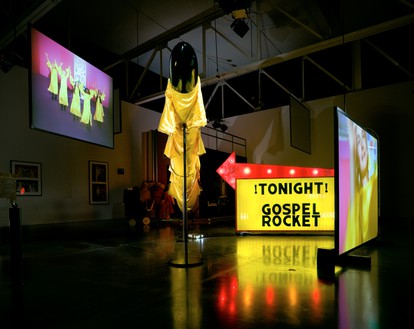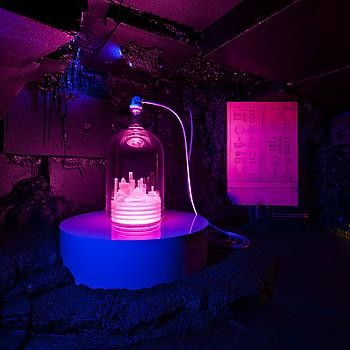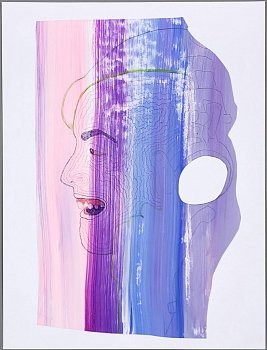About
Key works by Mike Kelley are on view at Gagosian Beverly Hills during the month of September.
The multimedia installation Extracurricular Activity Projective Reconstruction #27 (Gospel Rocket) (2004–05) comprises an illuminated movie sign, projected videos of a gospel choir, and a huge black rocket dressed in a lengthened version of the choir’s silky yellow vestments. It is one chapter of Kelley’s ambitious project Day Is Done, an expansion of the Extracurricular Activity Projective Reconstructions: 365 video narratives based on photographs from high school yearbooks. Presented at Gagosian West 24th Street in New York in 2005, Day Is Done included twenty-five discrete yet related sculptural installations that incorporated the set pieces and props from the videos. Gospel Rocket, with its glowing sign announcing a ceremonial rocket launch, attests to Kelley’s interest in the aspects of organized social behavior that merge spectacle, science, and belief.
Two of the nineteen Lenticular works are also on view. In the late 1990s, Kelley was invited to participate in a group show at the Kunstmuseum Bonn, Germany, that would focus on the then-upcoming millennial change. The exhibition examined the ways in which people have imagined the future throughout history. Kelley turned to Superman comics, specifically the superhero’s birthplace, Kandor. Though Kandor was assumed to have been destroyed, it was actually shrunk and bottled by the villain Brainiac, then later rescued by Superman, who kept it inside a bell jar in his Fortress of Solitude. Fascinated by the tiny futuristic city, a symbol for Superman’s feelings of alienation, Kelley collected hundreds of different comic-book images of Kandor and produced large-scale glass and resin sculptures that show hybrid versions of the city, merging Bauhaus or Art Deco styles with simple boxy drawings or ambiguous scribbles. The graphically altered images of Kandor were then blown up to the same scale as the sculptures and placed in lenticular light boxes, so that the viewer’s movement could affect the appearance of the city. In Lenticular 15 (2007), the bell jar and city are visible from one angle, then disappear from another, and in Lenticular 4 (2007), Kandor can be seen from above, but then seems to vaporize beneath a warm yellow glow.



